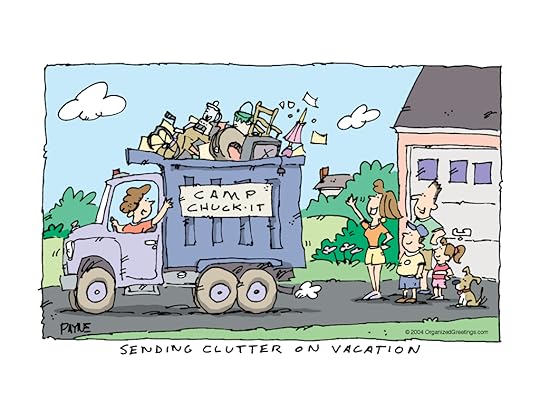Organizing Questions and Answers – Part 2
As the author of 11 books on how to declutter, organize and simplify your life, I get a lot of questions from my readers. I thought it might be helpful to share some of these organizing questions and answers with you in a series of blog posts. Here’s Part 1 if you missed it.

Q. How long do I need to save paperwork?
What is the length of time you should keep paid bill stubs, insurance records, receipts, and miscellaneous paperwork? I know you should keep three years of tax documents, but I’m not sure about the rest and I’m nervously keeping too much paperwork that is getting out of control! I can’t get a system going and have piles everywhere, which of course, stresses me out.
A. Keep only for legal or financial reasons.
The main determining factor for deciding what to keep and what to toss is this: Do you need to keep it for legal or financial reasons? If yes, save the paper.
As to what records you need to keep and for how long, please refer to this IRS publication. Some things you won’t find in this document, but may be helpful, include the following:
Keep ATM and debit card receipts only until you have received your bank statement (or reviewed your online statement) and everything checks out. Then shred them.
Keep credit card receipts until you have verified the amounts on your credit card bank statement. Then shred them.
EXCEPTION 1: If the purchase is a business expense, file the receipt.
EXCEPTION 2: You may want to save all receipts for a few months in case you decide to return something. Set up a folder for “2020 Receipts.”
EXCEPTION 3: You may want to save receipts for more expensive items that come with a warranty – file them with the product warranty and/or manual.
Unless they are business expenses, most bill statements can be thrown away as soon as they are paid: cable, water and sewer, telephone, electric. There is no legal or tax reason to save these statements and they do not prove payment. Your cancelled check proves payment.
Keep only current insurance policy documents. Shred out-of-date documents.
You mentioned knowing that you need to keep tax documents for three years. I just want to clarify for readers that this needs to be three completed years plus the current year – and that’s the minimum requirement. If you have any reason to worry about a tax audit, you may be more comfortable keeping the documents for seven years. Keep the actual prepared tax return documents indefinitely.
If you would like a simple filing system, I highly recommend Freedom Filer. It’s actually a self-purging system that is designed to help you determine what to keep and what you can toss.
I hope this information is helpful and will enable you to get rid of a lot of unnecessary paper clutter. Just please be sure to shred or burn any documents that include your name plus any account numbers to decrease the possibility of identity theft.
Q. What’s a good rule for maintaining an organized closet?
I know you’re going to think this is a really stupid question, but what is a good rule of thumb for keeping a wardrobe within a reasonable boundary? What I mean is: How many pair of shoes do I really need? How many pair of pants? How many t-shirts? ow many dresses? Do you have any suggestions for how to cut back on the number of clothes I have? I feel like they’re taking over my life.
A. Let go of anything that doesn’t make you look good and feel good when you try it on.
I don’t think that’s a stupid question at all! There is a rule of thumb, but it doesn’t have to do with how many items you keep.
The rule of thumb is: If you haven’t worn something in a year or more, let it go. Now that’s a pretty general rule. I kept two pair of shorts for six years that didn’t fit me on the off chance that I might be able to get into them again, which I did. But I would not save an entire wardrobe of clothes that no longer fit – just your favorites, just in case.
Another thing I recommend is to model everything you own in front of a trusted friend or family member. You already know what feels good on you. The friend can help you decide what looks good on you. Get rid of anything that doesn’t make you look and feel good when you wear it. Tip: It helps to start by pulling out your favorite clothes – the “for sure” keepers.
If you have trouble letting go of clothing, you might want to do it in stages. Go ahead and pare down your wardrobe and then put the cast-offs in a box or another closet somewhere. If another six months to a year goes by and you haven’t miss them, then you probably never will.
You might want to read this blog post featuring photos of my closet and tips for keeping your closet organized.
One last piece of advice. Keep only the current season’s clothing in your closet and drawers – and only items that currently fit. It will really simplify your life!
Do you have organizing questions?
What’s your organizing question for me? Leave a comment!
Full Disclosure: Some links in this blog post are affiliate links. If you click a link and purchase something, I will get a small percentage of the sale (at no additional cost to you). Please know that I only recommend products or services I use personally and/or believe are of value to my readers.
The post Organizing Questions and Answers – Part 2 appeared first on Declutter Your Life with Donna Smallin Kuper.
The One-Minute Organizer Blog
- Donna Smallin Kuper's profile
- 45 followers



